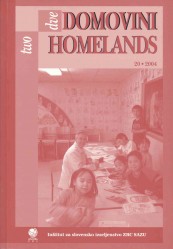TRANSFORMACIJA ETNIČNOSTI: PREMIK K JAVNEMU IZRAŽANJU SIMBOLNE ETNIČNE IDENTITETE
Povzetek
Pri otrocih slovenskih izseljencev v Avstraliji, ki so na južno celino prišli večinoma v petdesetih, šestdesetih in sedemdesetih letih 20. stoletja, lahko sledimo dinamičnemu občutku pripadnosti, ki ni nespremenljivo zavezan določenim vzorcem kulture, ampak lahko uspešno krmari med različnimi vidiki te kulture, pa tudi med kulturami samimi. V avstralski družbi se že pri drugih generacijah slovenska etničnost kaže kot fleksibilna, simbolična in prostovoljna. Po eni strani vsekakor še vedno temelji na njihovih osebnih izkušnjah, povezanih s primarnimi družinami in s preteklostjo, po drugi strani pa ista generacija etničnost doživlja na drugi ravni, ki se velikokrat vključuje v javno podobo posameznikov. Identifikacija z določeno etnično skupino je postala v sodobni družbi vsaj navidezni, če že ne realni garant širših razumevanj ter globalnejših pogledov. Na takšno prepričanje velikokrat vplivajo mediji, tako večinski kot manjšinski, etnični, ki jo v javno sfero vnašajo. Etnični delujejo na številčno veliko manjši populaciji, vendar pri mnogih etničnih skupinah še vedno krepijo etnično identiteto, gradijo pa tudi javno podobo posameznih kultur. V preteklosti so bili med etničnimi pomembnejši predvsem radijski programi, danes se zdi, da njihov položaj prevzemajo novejši mediji.
Ena izmed številnih etničnih skupin, ki danes ustvarjajo svoj etnični program na dveh radijskih postajah v avstralskem Melbournu, SBS in 3ZZZ, je tudi slovenska. Vendar pa slovenski etnični radijski medij na obeh postajah služi skoraj izključno slovenskim izseljencem prve generacije in tako ne vključuje precej pripadnikov druge in tretje generacije, ki se s to etničnostjo tudi vsaj delno identificirajo. Programske značilnosti slovenskega programa so vezane na fizično bližino in na stereotipne, tradicionalne oblike; tako pa slovenski etnični radijski program vsaj v večji meri ne vpliva na oblikovanje ali ohranjanje etničnih identitet druge in naslednjih generacij. Novo in nekoliko drugačno dinamiko v slovenski skupnosti v Avstraliji bi lahko ponudil internet, predvsem z etnično obarvanimi spletnimi stranmi Thezaurus, ki jih oblikujejo Slovenci v Melbournu. Spletne strani namreč ustvarjajo nov prostor za komunikacijo, interakcijo in debato (predvsem s svojimi razpravnimi forumi). Vendar pa je za ljudi s slovenskimi koreninami v Avstraliji skoraj nemogoče napovedovati, da bodo etnično ozaveščeni posamezniki internet uporabljali kot glavno polje krepitve svoje multiple etnične identitete. Vsekakor pa lahko takšne spletne strani postanejo interaktivni kanal za pridobivanje kompleksnejših informacij o slovenski kulturi, na podlagi katerih si mlajše generacije izoblikujejo mnenje o njej, s tem pa tudi izberejo in oblikujejo lastno etnično identiteto.
Prenosi
Literatura
A lba, Richard (1990): Ethnic Identity: The Transformation o f W hite America. New Haven, New York: Yale University Press.
Anthias, Floya (200 1), New hybridities, old concepts: the limits o f ‘culture’, Ethnic and Racial Studies, 24, 4, str. 619-641.
Ceferin, Aleksandra (2003): Slovenian Language in Australia: 25 vears o f Slovenian Language in Victorian Schools: Institute for Slovenian Studies ofV ictoria 1977¬ 2002. Clayton North: Institute for Slovenian Studies o f Victoria.
Elkins, David J. (1997), Globalization, Telecomunication and Virtual Ethnic Communities, International Political Science Review, 18, 2, 139-152.
Elkins, David J. (1999), Think Locally, Act Globally: Reflections on Virtual N eighbourhoods, Javnost/The Public, 6, 1, 37-54.
G ans, Herbert J. (1979), Sym bolic Ethnicity: the Future ofE thnic Groups and Cultures in America, E thnic andR acialStudies, 1, 1, str. 1-20.
Gans, Herbert J. (1994), Symbolic Ethnicity and Symbolic Religiosity: Towards a Comparison o f Ethnic and Religious Acculturation, Ethnic and Racial Studies, 17,4, str. 557-592.
Glazer, Nathan in M oynihan, Daniel P. (1996), “Beyond the M elting Pot”, Ethnicity (uredila John Hutchinson in Anthony D. Smith, New York, Oxford: Oxford University Press, str. 135-138.
Hall, Stuart (1997), “Introduction. Who needs Identity?”, Questions o f Cultural Identity (uredila Stuart Hall in Paul Du Gay), London, Thousand Oaks, New Delhi: Sage Publications, str. 117.
Hutchinson, John (1996), “Ethnicity and M ulticulturalism in Immigrant Societies”, Ethnicity (uredila John Hutchinson in Anthony D. Smith, New York, Oxford: Oxford University Press, str. 374-378.
Hutchinson, John (2000), Ethnicity and modem nations, Ethnic and Racial Studies, 2 3 ,4 , str. 651-669.
Južnič, Stane (1993): Identiteta. Ljubljana: Fakulteta za družbene vede.
Lukšič Hacin, M arina (1999): M ultikulturalizem in migracije. Ljubljana: Založba ZRC.
M allapragada, M adhavi (2000), “The Indian Diaspora in the USA and around the Web”, Web, Studies: Rewriting M edia Studies fo r the Digital Age (uredil David Gauntlett), London: Arnold, str. 179-185.
Mlinar, Zdravko (1994): Individuacija in globalizacija vprostoru, Ljubljana: SAZU.
Poole, Elizabeth (2002), Networking Islam: The Democratising potential ofnew Technologies in relation to M uslim Communities, Javnosti The public, 9, 1, str. 51-64.
Rheingold, H ow ard (2000), “Com munity Development in the Cybersociety o f the Future”. Web. Studies: Rewriting M edia Studies fo r the D igital Age (uredil David Gauntlett), London: Arnold, str. 170-179.
Skrbiš, Zlatko (1999): Long-distance Nationalism: Diapsoras, Homelands andldentities, Aldershot: Ashage.
Skrbiš, Zlatko (2003), Diasporično slovenstvo: politika, nacionalizem in mobilnost, D ružboslovne razprave, 19, 42, str. 9-20.
Waters, Mary C. (1990): Ethnic option; Choosing Identities in America. Berkley, Los Angeles, Oxford: University of California press.
Young, Robert (1996): Colonial Desire: Hybridity in Theory, Culture and Race, London: Routledge.
Prenosi
Objavljeno
Kako citirati
Številka
Rubrike
Licenca

To delo je licencirano pod Creative Commons Priznanje avtorstva-Nekomercialno-Brez predelav 4.0 mednarodno licenco.
Avtorji jamčijo, da je delo njihova avtorska stvaritev, da v njem niso kršene avtorske pravice tretjih oseb ali kake druge pravice. V primeru zahtevkov tretjih oseb se avtorji zavezujejo, da bodo varovali interese založnika ter da bodo povrnili morebitno škodo.
Podrobneje v rubriki: Prispevki





